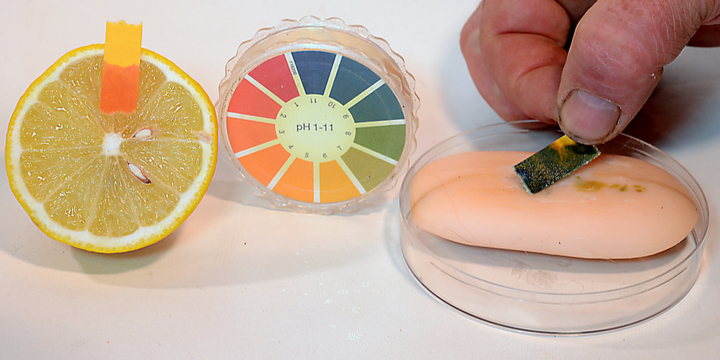When it comes to food, you often hear about acid products that can hurt your stomach, that you need to take baking soda to calm your stomach. There are lots of confusions and confusions, partially wrong definitions. Added to this are questions of acid-base diet, well-being, the fight against irritability or stress, etc. which complicate matters.
The “oil is acidic”, “the tomato is alkaline”, “the vegetable juices are alkaline”, “the lemon shines by its alkaline power” … You have to go back to chemistry lessons, and explain what mean these terms: acidity, alkalinity.
PH, a unit of measurement
Most food, like humans, is made up of water. We must think in an aqueous medium, and define the pH as the concentration of hydrogen ions. The pH also means: Potential Hydrogen.
Under these conditions, neutral = pH 7, acidic, between 1 and 7, and basic (or alkaline) between 7 and 14.
Tomato juice has a pH of 4, it is acidic.
The oil is not soluble in water so it is not possible to define its pH in this standard, neither acidic nor basic. Even if it is oleic acid like olive oil. It will take another reference than water to define its acidity, in any case, it is not possible to put on the same level the acidity of the oil and the acidity of a tomato.
The stomach is acidic
We eat between pH 2 and pH 8 approximately. As a reminder, concentrated hydrochloric acid is around 1, caustic soda is around 12-13.
The hydrochloric acid that ends up in our stomach is stomach acid. Some cells produce hydrochloric acid. This hydrochloric acid breaks down food to transform it into assimilable nutrients, so it is very acidic.
In the stomach, food is alkaline
It is important to distinguish an acid product in itself from a product capable of giving acidity in another medium. Acidic and acidifying are not the same thing. Alkaline and alkalizing either.
The definition of acidity given is based on a reference: water (pH 7). However, in the stomach, the reference, in a way, is concentrated acid at a pH between 1 and 3, in other words for the stomach, almost all foods are alkaline, because their pH is higher than that of stomach.
Does cola help digestion?
Tomato is sour in the same way cola can be too. The belching comes from the fact that the gas dissolved in the cola comes out. So there was an acid base reaction in our stomach. The carbonate is transformed into carbonic acid: CO2. This amounts to saying that cola was the base, and stomach acid was indeed acid. It’s an acid-base reaction, in the end the stomach acid is a little less acidic, and the cola has become a little more acidic. The 2 neutralize each other.
Cola, like lemon juice, is acidic (pH around 2), which stabilizes the acidity in the stomach, and therefore stomach acid remains very effective for digestion and to help dissolve food.
What to do about heartburn?
For heartburn, it is necessary to ingest a very basic product to neutralize part of the stomach acid. The products that are easy to identify are: carbonate, citrate, alginate… often everything that ends in –ate is basic. What ends in -ic is acidic.
Dissolving carbonate in water simulates a carbonated drink. Then pour into an acid solution, it foams.
For heartburn, baking soda should be avoided because 2-3L of gas will form. On the other hand, a widely used product is citrate. Lemon contains citric acid, its basic form is citrate. When you ingest citrate, an acid-base reaction takes place: this citrate base becomes citric acid, and stomach acid becomes water. Overall, in this reaction, the final pH increases.
All the foods will interact with each other, causing lots of acid-base reactions. Eating sour rhubarb, a little less acidic tomato, so-called “basic” broccoli etc … will create a lot of neutralization reactions.
Can sugar lower acidity?
The sugar is to be forgotten, in the mouth it will seem less acidic, but the acidity does not change at all. If you pour sugar into vinegar… and measure the pH, nothing happens.
You can dilute it but here too, be careful with received ideas. To change the pH by a notch, for example going from 2 to 3, the preparation must be diluted by 10.
To change the pH from 2 to 4, it will therefore be x100. If your sauce is too acidic, it will take gallons of water to compensate for its acidity, so this is not the right method. For your acidic lifts, unnecessary, and even dangerous, to drink liters of water, you risk the acid peak of the end. And especially useless to believe in all the nonsense read on the internet.
 Cherry tomatoes contaminated with salmonella: 92 sick and 1 dead
Cherry tomatoes contaminated with salmonella: 92 sick and 1 dead  A better coaching method can make a person grow
A better coaching method can make a person grow  What is the method to prevent diabetes in children?
What is the method to prevent diabetes in children?  What are the effective factors in causing stomach ulcers?
What are the effective factors in causing stomach ulcers?  Why do embarrassing memories seem to appear at night?
Why do embarrassing memories seem to appear at night?  The amazing link between SARS-CoV-2 infection and newly started diabetes
The amazing link between SARS-CoV-2 infection and newly started diabetes  WHO says monkey pox is not a global emergency right now
WHO says monkey pox is not a global emergency right now  Single cell RNA sequencing uncovers new mechanisms of heart disease
Single cell RNA sequencing uncovers new mechanisms of heart disease  Hepatitis of unknown origin: 3 new deaths and 228 cases worldwide
Hepatitis of unknown origin: 3 new deaths and 228 cases worldwide 